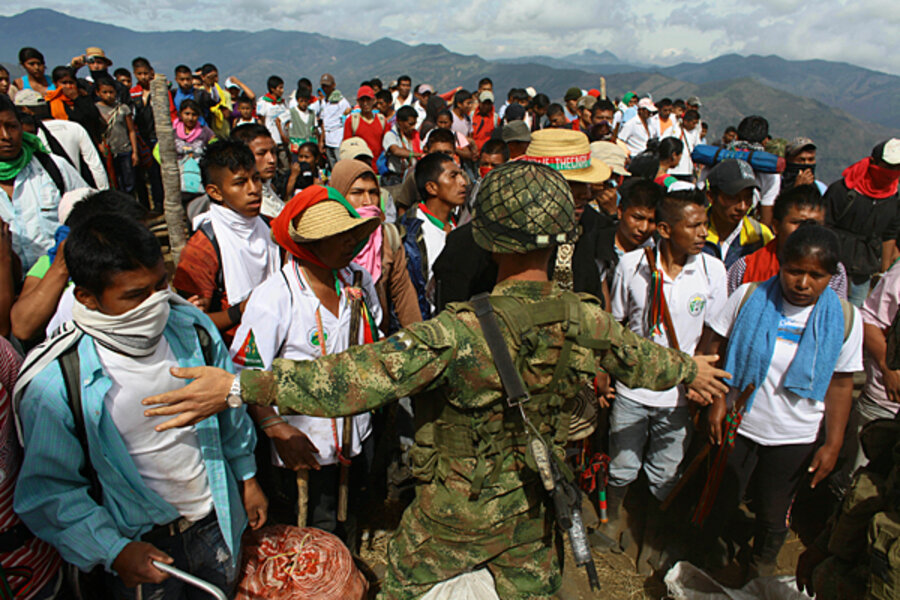Caught in FARC-government crossfire, Colombia's Nasa say 'get out'
Loading...
| Toribío, Colombia
For the three FARC guerrillas and a young accomplice captured by an indigenous tribe, each punishment option must have seemed as bad as the next. Hundreds of members of Colombia’s native Nasa community gathered at a school last weekend to decide if they should be publicly flogged, hung from their feet, or buried up to their necks for 24 hours.
The rebels had been captured days earlier by the tribe’s “Guard” – an army that does not carry weapons and counts women, children, and the elderly among its members. Nasa land, situated in the lush mountains of Colombia’s southwestern Cauca department, has in recent decades become a key battleground between government troops and leftist insurgents of the Revolutionary Armed Forces of Colombia (FARC). Sick of years caught in the crossfire, tribe members say they’ve had enough.
“We are the authority in our ancestral territory,” Jesus Chavez, head of Cauca’s regional indigenous council, told a Nasa assembly last weekend. The tribe has ordered all armed actors to leave the region, embarking on a series of operations targeting both the Army and the FARC to show it means business.
But President Juan Manuel Santos says he will not demilitarize “even one centimeter” in an area that is a historic guerrilla stronghold and major drug-trafficking corridor. The worsening security situation is a major challenge for him both at home, where critics say a soft-line security approach is leaving swaths of rural Colombia out of control, and abroad, as he promotes the image of a transformed, investment-friendly country.
“This is a political defeat for the Santos government,” according to Colombian conflict analyst Jorge Restrepo. Santos has emerged as a major regional player since assuming the presidency in 2010, implementing historic legislation to compensate victims of Colombia’s armed conflict, healing relations with Ecuador and Venezuela, and finalizing a Free Trade Agreement with the United States. But this outbreak of violence, an embarrassing reminder that Colombia’s decades of internal conflict are far from over, “puts in question his ability to win re-election," says to Mr. Restrepo.
Crying soldiers, public lashings
After marching earlier this month to demand autonomous rule, the Nasa climbed to the top of a 7,500-ft. mountain near Toribio – a town that has become an epicenter of FARC operations and military counterstrikes – and drove hundreds of soldiers off a military base, correctly predicting they would not open fire.
Scenes of crying soldiers being dragged from their camp by unarmed peasants caused outrage among many Colombians, who accused President Santos of allowing his Army to be humiliated. He sent in riot police the next day who retook the base armed with guns and tear gas; dozens of Nasa were injured. Later, a 22-year-old indigenous man was shot dead “in error” by a soldier at a nearby checkpoint, adding to their rage.
Next, the Nasa captured the four FARC collaborators, holding them at an evangelical school that has become a headquarters for their resistance movement. Voting by show of hands during a community trial last Saturday, they handed down their sentence – 30 lashes each with a leather whip; 10 for the teenager.
The prisoners’ evident pain during the flogging divided the crowd. “You have the hearts of dogs,” and “Don't you have sons?" yelled some at those demanding the whippings be completed. The 16-year-old captive fell to the floor in tears after just a few hits, as his family pleaded for mercy. Each lashing was stopped early.
It was a remedy more than a punishment, said the Nasa, the same traditional tribal penalty that a member would receive for rape, domestic violence, or murder. “It’s a spiritual act of correction to bring back harmony to these people and their families,” says national Nasa spokesman Feliciano Valencia.
Infiltrated by the FARC?
The Nasa also hoped the ritual would counter government claims that the tribe has been infiltrated by the FARC – charges they vehemently deny. For Luis, one of 35,000 extra troops drafted into Cauca in recent weeks, the roots of the resistance are clear. “The guerrillas are behind this. The indigenous people are being influenced by them,” he says, speaking unauthorized from a nearby army camp. Some innocent Nasa must be caught in the middle, he acknowledges. “But that’s life in Colombia,” he says.
United Nations representatives arrived this week to oversee talks between Interior Minister Federico Renjifo and indigenous leaders. But locked in a stalemate – the Nasa demanding the government withdraw all troops from Cauca while Santos pledges he will not demilitarize, it’s easy to see why, in the words of the government’s national indigenous rights ombudsman Horacio Guerrero, “public opinion is skeptical that an agreement will be reached.”
But “the law is on the Nasa’s side,” he says. According to Mr. Guerrero, who will mediate during negotiations, both international law and the Colombian Constitution oblige the government to get the consent of indigenous people before establishing military bases on their territories. “The government has to respect those norms,” Guerrero says.
Meanwhile, the Nasa say they expect Saturday’s flogging to spark revenge attacks from the FARC. “Of course we’re scared of them, but we can’t keep living like this,” says Mr. Valencia, the Nasa spokesman. “This is about dignity. A dignified people defending a hope for peace. I tell the guerrillas, the police, the military: What you are doing is killing each other. We’re tired of it and you must leave.”





